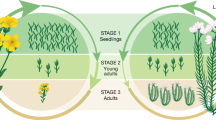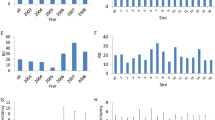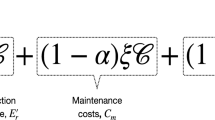Abstract
DETERMINISTIC models demonstrate that when the economic dis-count rate of future harvests exceeds a critical value related to population growth rate, the strategy that maximizes the present value of cumulative harvest is immediate extinction (liquidation) of the population1–3. Here we analyse stochastic models to derive optimal strategies that maximize the expected present value of cumulative harvest before extinction of a fluctuating population. Stochastic models reveal that discount rates below the critical value can substantially reduce the mean time to extinction and the expected real harvest before extinction. With an unstable equilib-rium at small population size (Allee effect4–6 or depensation2), the critical discount rate is lower in the stochastic model than in the corresponding deterministic model. These results argue against economic discounting in the development of optimal strategies for sustainable use of biological resources.
This is a preview of subscription content, access via your institution
Access options
Subscribe to this journal
Receive 51 print issues and online access
$199.00 per year
only $3.90 per issue
Buy this article
- Purchase on Springer Link
- Instant access to full article PDF
Prices may be subject to local taxes which are calculated during checkout
Similar content being viewed by others
References
Clark, C. W. Science 181, 630–634 (1973).
Clark, C. W. Mathematical Bioeconomics 2nd edn (Wiley, New York, 1990).
May, R. M. Nature 263, 91–92 (1976).
Allee, W. C., Emerson, A. E., Park, O., Park, T. & Schmidt, K. P. Principles of Animal Ecology (Saunders, Philadelphia, 1949).
Fowler, C. W. & Baker, J. D. Rept International Whaling Commission 41, 545–554 (1991).
Dennis, B. Natural Resource Modeling 3, 481–538 (1989).
Ludwig, D., Hilborn, R. & Walters, C. Science 260, 17, 36 (1993).
Redford, K. H. BioScience 42, 412–422 (1992).
Primack, R. B. Essentials of Conservation Biology (Sinauer, Sunderland. MA. 1993).
Goombridge, B. (ed.) Global Biodiversity: Status of the Earth's Living Resources (Chapman & Hall, New York, 1992).
Cumming, D. H. M., Du Toit, R. F. & Stuart, S. N. African Elephants and Rhinos. Status Survey and Conservation Action Plans (International Union for the Conservation of Nature and Natural Resources, Gland, Switzerland, 1990).
Miller, G. T. Jr Living in the Environment. An Introduction to Environmental Science 6th edn (Wadsworth, Belmont, CA, 1990).
Le Boeuf, B. in The Natural History of An̄o Nuevo (eds Le Boeuf, B. & Kaza, S.) Ch. 7. 287–325 (Boxwood, Pacific Grove, CA. 1981).
Halliday, T. Vanishing Birds: Their Natural History and Conservation (Penguin, Harmonds-worth, 1980).
Van Valen, L. Evol. Theory 1, 1–30 (1973).
Jablonski, D. Science 231, 129–133 (1986).
Beddington, J. R. & May, R. M. Science 197, 463–465 (1977).
May, R. M., Beddington, J. R., Horwood, J. W. & Shepherd, J. G. Math. Biosci. 42, 219–252 (1978).
Reed, W. J. Math. Biosci. 41, 273–307 (1978).
Karlin, S. & Taylor, H. M. A Second Course in Stochastic Processes (Academic, New York, 1981).
Lande, R., Engen, S. & Saether, B.-E. Am. Nat. (in the press).
Daley, H. E. & Cobb, J. B. Jr For the Common Good. Redirecting the Economy Toward Community, the Environment, and a Sustainable Future (Beacon, Boston, 1989).
Keller, H. B. Numerical Methods for Two-Point Boundary Value Problems (Blaisdale, New York, 1968).
Author information
Authors and Affiliations
Rights and permissions
About this article
Cite this article
Lande, R., Engen, S. & Saether, BE. Optimal harvesting, economic discounting and extinction risk in fluctuating populations. Nature 372, 88–90 (1994). https://doi.org/10.1038/372088a0
Received:
Accepted:
Issue Date:
DOI: https://doi.org/10.1038/372088a0
This article is cited by
-
De Finetti’s Control Problem with Competition
Applied Mathematics & Optimization (2023)
-
Stochastic growth, conservation of capital and convergence to a positive steady state
Economic Theory (2023)
-
Consequences of barriers and changing seasonality on population dynamics and harvest of migratory ungulates
Theoretical Ecology (2020)
-
Optimal harvesting strategy of a stochastic inshore–offshore hairtail fishery model driven by Lévy jumps in a polluted environment
Nonlinear Dynamics (2019)
-
Mode change in the dynamics of exploited limited population with age structure
Nonlinear Dynamics (2018)
Comments
By submitting a comment you agree to abide by our Terms and Community Guidelines. If you find something abusive or that does not comply with our terms or guidelines please flag it as inappropriate.



